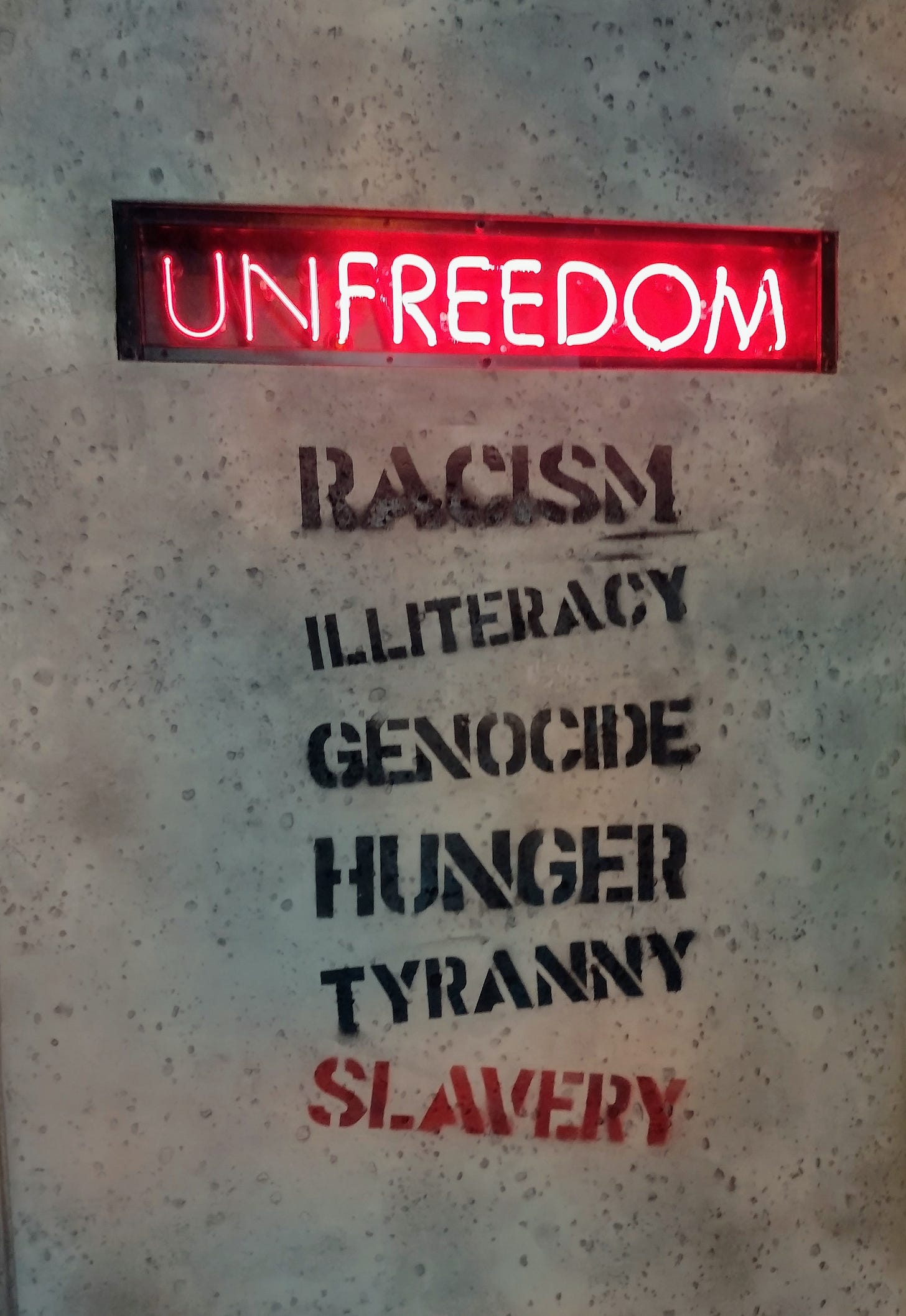Cry Freedom: The Underground Railroad and Its Museum
ANNETTE ON THE ROAD A Gobsmacking Museum, Supposedly Focused on the Underground Railroad that Brought Enslaved People North To Freedom, Tells a Much Bigger Story.
How Long is This Post? 3,400 words, approx 15 minutes, with lots of lovely photos.

Note from Annette
Some museums are just too bloody big. Consider the British Museum, the first ever museum. Being first, it didn’t have any true role models. So its curators just did what private collectors did, when they collected fun stuff in a “cabinet of curiosities”. The British Museum accepted all the old random crap that came their way, so long as it was interesting, and created the world’s largest “cabinet of curiosities” It had more in common with Ripley’s Believe it Or Not [UK readers: Tourist trap like Madam Tussauds] than with a modern museum. The British Museum struggles with that legacy. When I asked a Georgia student of mine on Study Abroad in London to tell me what the British Museum is about, he extended his arms, and exclaimed, “EVERYTHING.” Yeah. Pretty much. It also has two miles of exhibit hallways across nearly a million square feet. I tend to pop in to see something very specific. Otherwise, it becomes a total chore to visit.
From The Top: Starting the Museum Backwards
When Hoosen [He Who Shall Not Be Named on the Internets, HWSNBNOTI, or Hoosen Benoti] and I came to today’s museum, in Cincinnati, Ohio, the National Underground Railroad Freedom Center (NURFC) (yeh, that’s a mouthful, and yes, a terrible acronym) we didn’t have any expectations. Okay, I had one very reasonable expectation: I expected the 19th Century, drawings of people fleeing through swamps in pursuit of freedom.
Ticket Guy strongly suggested we start on the 3rd floor. You know what? I listen to suggestions like these. I was glad I did. But I didn’t expect to see this greeting us:
SLAVERY EXISTS AROUND THE WORLD TODAY. MEN AND WOMEN, TEENAGERS AND CHILDREN FROM ALL BACKGROUNDS ARE FORCED TO WORK AGAINST THEIR WILL UNDER THREAT OF VIOLENCE, AND WITH NO READY MEANS OF ESCAPE.ALTHOUGH SLAVERY IS EVERYWHERE, IT IS LARGELY INVISIBLE.
Or this:
(UN) FREEDOM [in red neon, with the UN flickering on and off] RACISM ILLITERACY GENOCIDE HUNGER TYRANNY SLAVERY
Perhaps you’re recoiling slightly. Perhaps you’re wondering what wokey nonsense awaited us. Don’t. I didn’t feel lectured to, but I should have been lectured to. I should have been asked why I wasn’t doing more. Still, while these are powerful words, how we respond is up to us. And the third-floor exhibit was relentlessly factual, even to the point of honestly explaining the difficulties of verifying data. But it left us shaken, and in no doubt that slavery globally—and in the US, and right there in Cincinnati, or wherever we live—is a staggering, horror story that didn’t end in 1863, 1865, or even 1965. It told stories of people trapped in modern-day slavery, and the massive scale of the the problem, of millions of adults and millions of children living hideous lives, trafficked around the world.
I don’t want to do spoilers here. But this third-floor exhibition was devastating. It was emotional. I used all the Kleenex I had. It was not about 19th century slavery, which makes me emotional enough. This was about now. See those signs in public restrooms about people being trafficked? See the news stories about police busts of people being held against their will and forced to work? This is a disaster hiding in plain sight. No wonder people get confused and buy into bizarre conspiracy theories. The truth is even worse.
Slavery is a story with deep roots that we understand in a shallow way, and a story that’s far from over. But why is a museum taking on an activist role? Because history is not just about the past.
Here’s the Museum’s statement on this exhibit:
MISSION STATEMENT
THE NATIONAL UNDERGROUND RAILROAD FREEDOM CENTER'S PROJECT MISSION IS TO ERADICATE MODERN-DAY SLAVERY
WITH OUR EXHIBITION PARTNERS, FREE THE SLAVES, GOODWEAVE, INTERNATIONAL JUSTICE MISSION, AND POLARIS PROJECT, THIS EXHIBITION IS INTENDED TO RAISE AWARENESS OF SLAVERY'S PRESENCE IN THE WORLD, ENCOURAGE CONTEMPORARY EFFORTS TO ABOLISH SLAVERY, AND INSPIRE ACTION TO END SLAVERY, ONCE AND FOR ALL.
If you’ve been reading me for awhile, you know I love a museum with a focused story, told in a way that’s easy for all of us to connect with (not just historians). That’s what I was expecting. What I got was far more complicated. And this first unexpected exhibition, on the the third floor, was a fantastic example of when that worked. I’m glad I was told to go to the third floor first, because if it had been at the end of the visit, I wouldn’t have made it there.
Think about why the Museum directed us there first. Consider the bitter irony of those who boldly claim “I would have done something about it if I’d been around back then” but do nothing now? In these troubled times, a lot more of us are thinking uneasily of what we don’t do. And anyone who studies African-American history is aware of such bitter ironies, including within ourselves.
So I loved this first exhibit. It was short, and packed a massive punch. What surprised me was that in the most critical parts of the Museum, showing how people fought back against 19th century slavery, the exhibits suffered from TMI (Too Much Information) A museum I expected to cruise through in a couple of hours defeated me--a museum warrior— after nearly five hours.
But I am glad I went, and I’m especially glad we started on the third floor. I never stopped thinking about what I saw there as I dived through the past.




